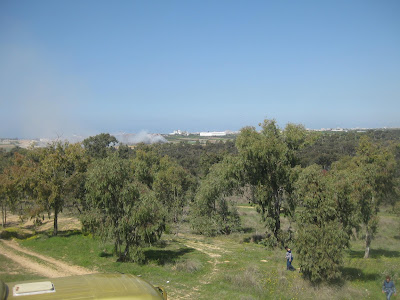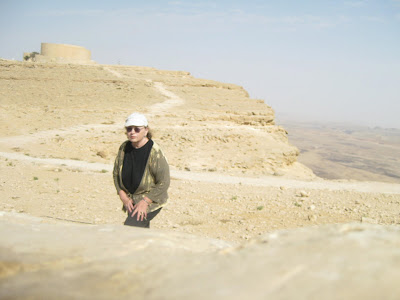To celebrate Spring arrival, I joined a guided day trip to the 'Red South' - 'red' referring to the wild red flowers (anemones) growing from December to March in various parts of the country, the southern part being one of them.
The weather was glorious - perfect for an outdoor escapade. During the trip we were treated with fresh strawberries, cookies, coffee, lemonade, cold water - stored in the underneath baggage compartment of the bus - and that made it all very pleasant.
red anemones
(By the way, Michelle Bachman, the american republican politician has served here as a volunteer in 1974).
Our trip included some interesting sites: wheat fields, bridges (the Rope Bridge), rivers (Tzehelim and Habesor which are subject to annual flooding following heavy rains), memorials (ANZAC) , and the port of Ashdod.
South of Beeri region - the "rope bridge" hanging over the Besor stream. It's 80 meters long. To take a picture while on the shaking bridge is not easy at all, as the hand shakes too.
the hanging 'rope bridge' - a bit of a frightening experience
not the work of DAESH but of my photographic incompetence
Some four kilometers north of Beeri - The ANZAC memorial in commemoration of the australian and new-zeelandish soldiers who fell in battle during first world war. From the top one can see Gaza Strip which is not far from the kibbutz (there are some eleven settlements near the border with Gaza Strip).
upper part of the structure
view of Gaza strip in the distance
At 1:00 p.m, still near Gaza Strip, we had lunch at a kibbutz, named Yad Mordechai in memory of Mordechai Anielewicz, a leading figure in Warsaw Ghetto Uprising of 1943.
This kibbutz's honey , jam, and olive products are leading brands on the israeli market. (I'm a fan of their "778" light blueberry jam which I use as a replacement for sweets - a tea spoon of jam has only 12 kalories).
dining hall of Yad Mordechai
lunch time
After lunch we headed towards the climax of our trip - Ashdod Port and its visitor center. The port , dominating the city of Ashdod, is located some 40 kilometers from Tel-Aviv. Here we were not allowed to take pictures except in and around the visitor center. At the visitor's center we were presented with a movie and explanations on the port's history and its impressive technological development.
visitor's center
containers
At the end of the ride we were offered as a memento, an envelope bearing the original stamp issued at the port's 50th Anniversary. Nice.






















